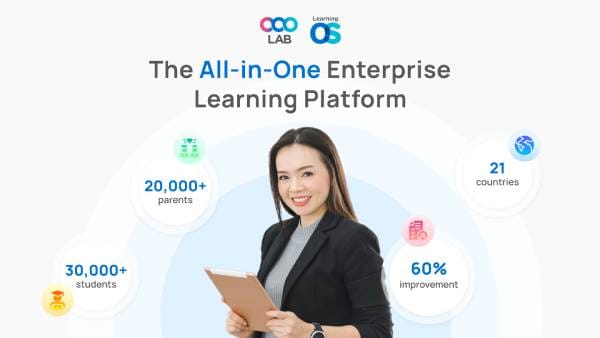In the past two years, the distinction between traditional and online training has become less clear as many companies have embraced a remote-first approach. The term 'hybrid' is increasingly popular and poised to embrace transformations that will shape the future of work environments and practices. The hybrid or blended learning approach is familiar to learning and development teams in different industries, serving as a crucial framework to support businesses in achieving success and growth.
As hybrid work culture continues to evolve, remote workers need to actively participate in, enhance, and adapt through efficient eLearning initiatives. Employees who possess appropriate skills and attitudes have the capability to fulfill customer requirements and achieve organizational objectives. Blended learning has demonstrated its value as a cost-efficient strategy to address the shifting priorities of leaders in learning and development.

I. What is blended learning?
Blended learning is an educational approach that combines traditional face-to-face classroom instruction with online learning activities. It integrates various learning modalities and resources to create a cohesive learning experience. Typically, in a blended learning environment, students have some control over time, place, path, and/or pace of their learning. This approach aims to leverage the strengths of both in-person and online learning to enhance engagement, flexibility, and effectiveness in education and training contexts.
Blended learning is fundamentally about flexibility. It leverages digital platforms to enable employees to access training materials at their own convenience and location. This approach also emphasizes the importance of in-person sessions for meaningful interactions with instructors and peers, promoting collaboration, teamwork, and deeper understanding of the content.
The 70:20:10 framework represents an optimal blended learning model for upskilling and reskilling efforts. It proposes that learners acquire knowledge and skills through a mix of on-the-job experiences, social interactions, and formal learning opportunities.
>>> Read more: Self-paced learning: Empowering employees to upskill at their own pace.
>>> Read more: Benefits of mobile microlearning for employee development
>>> Read more: 10 ways LMS can revolutionize your corporate training
II. The purpose of blended learning
Blended learning accommodates learners of different skill levels by allowing them to progress at their own preferred pace. It enables fast learners to advance quickly and gives struggling learners the flexibility to learn at their own speed, with personalized support available when they encounter difficulties. In contrast, traditional classrooms typically impose a uniform pace of instruction, leading to disengagement among quick learners and challenges for those needing extra help. The scalability of blended learning ensures effective instruction at all levels, preparing every learner to succeed by acquiring the necessary skills essential for excelling in their roles.
III. Different types of blended learning
There are several types of blended learning models, each with distinct characteristics. The selection of a model depends on factors such as institutional goals, learner requirements, available resources, and the level of technological infrastructure. These include:
1. Rotation Model: Learners move between different learning stations or modalities, including face-to-face instruction, online learning, small group activities, and individual assignments. For instance, learners might switch from a physical classroom to online activities or workstations. This model facilitates personalized learning experiences, flexible pacing, and varied content delivery.
2. Flex Model: Learning primarily occurs online, allowing learners to control the timing, location, and speed of their studies. They access instructional materials and complete assignments remotely, often with support from an on-site facilitator. The flex model enables personalized learning tailored to diverse learner needs and schedules.
3. Self-Blend Model: Learners supplement traditional face-to-face classes with additional online courses or resources, such as an online language course outside their regular curriculum. This model supports exploration and customization based on learners' interests and learning objectives.
4. Online Lab Model: Learners engage primarily in online learning but have access to a physical space like a computer lab or learning center for instructor support or collaborative work with peers. This model combines the convenience of online learning with in-person interaction and assistance.
5. Flipped Classroom Model: Traditional instruction sequence is reversed where learners first learn new content online through videos, readings, or interactive modules. Classroom time is then used for discussions, projects, and activities that reinforce and apply what they've learned. This model promotes active learning and deeper understanding through collaborative efforts and direct engagement with the instructor.
6. Enriched Virtual Model: Most learning happens online, with occasional face-to-face sessions for additional support, collaborative projects, or hands-on activities. The online component offers flexibility for learners to progress independently, while in-person sessions provide social interaction and personalized guidance.
Implement your LMS for your corporate training TODAY

IV. How do companies set up blended learning for corporate training
To begin implementing blended learning, organizations can follow these steps:
1. Evaluate needs: Identify training needs and areas where performance can be improved.
2. Establish objectives: Define clear goals that align with the organization's strategic objectives.
3. Choose delivery methods: Select a combination of online and offline approaches.
4. Develop content: Create or curate engaging and relevant learning materials.
5. Design learning paths: Plan structured sequences of activities and assessments.
6. Utilize an LMS: Implement a learning management system to manage and track content delivery.
7. Offer support: Provide resources, mentoring, and technical assistance as needed.
8. Assess and refine: Continuously evaluate effectiveness and make adjustments for improvement.
V. Conclusion
Every organization should adopt a blended learning approach to maximize their workforce potential and overall success. By combining traditional instructor-led training (ILT) with methods like social learning, online videos, and VR/AR, learning becomes more effective, personalized, and accessible. Blended learning is particularly beneficial for diverse teams working from various locations and possessing different skill sets, offering a versatile solution for L&D initiatives.
About us
At OOOLAB (pronounced 'uːlæb'), our mission is to make complex learning operations simple. We aim to positively impact the lives of over 1,000,000 learners and educators by the end of 2026.
OOOLAB's LearningOS provides educational institutions and corporate enterprises with an all-in-one solution to create and deliver engaging learning experiences.
Reach out to us at: Linkedin, FaceBook


